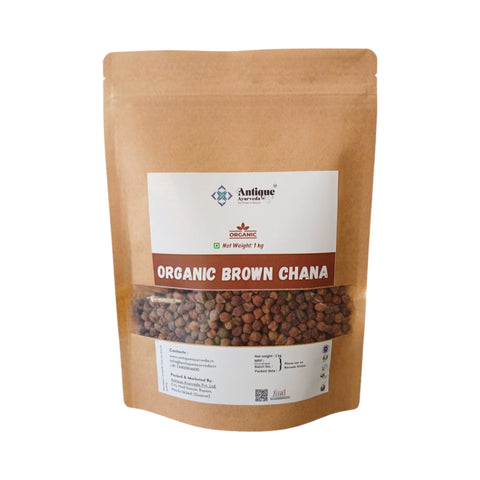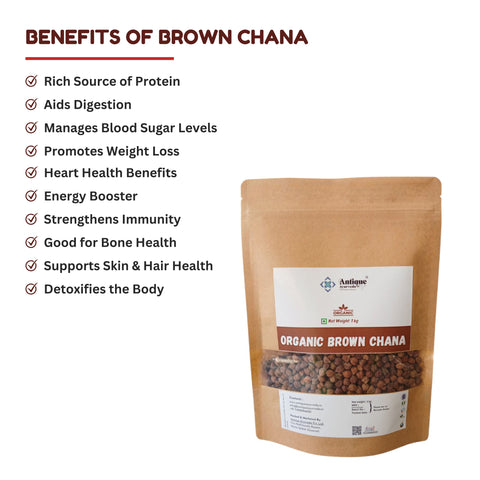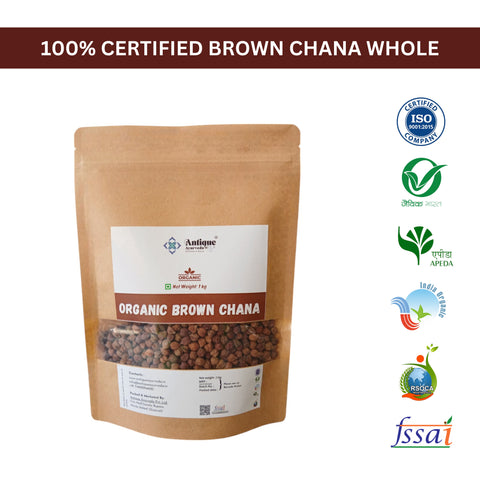




Organic Kala Chana | Premium Black Chickpeas
Use this code to get 10% discount
Product Description
Organic Kala Chana, also known as Black Chickpeas or Black Bengal Gram, are nutrient-dense legumes with a distinctive dark brown to black outer skin. Unlike regular white chickpeas (safed chana), kala chana has a nuttier flavor, firmer texture, and superior nutritional profile. These ancient legumes have been cultivated in India for over 4,000 years and remain a cornerstone of traditional Indian nutrition and Ayurvedic medicine.
Ancient Indian Superfood: Kala chana represents the original chickpea variety that has nourished Indian civilization for millennia. This dark-skinned legume carries the concentrated wisdom of traditional agriculture, offering superior nutrition and medicinal properties that have made it indispensable in Ayurvedic healing and daily Indian cuisine.
Nutritional Supremacy: Unlike modern hybrid varieties, kala chana retains its ancestral nutritional density with higher fiber, protein, and antioxidant content. The dark skin contains powerful anthocyanins - the same compounds that give blueberries their superfood status - making kala chana a true nutritional powerhouse in legume form.
Ancient Superfood Benefits
Protein Powerhouse: 20g protein per 100g with complete amino acid profile
High Fiber Content: 17g fiber per 100g supports digestive health and gut microbiome
Iron Rich: 7mg iron per 100g prevents anemia and boosts energy naturally
Folate Source: Essential for pregnant women and cellular health
Magnesium & Phosphorus: Supports bone health and muscle function
Low Glycemic Index: Excellent for blood sugar management and diabetes control
Antioxidant Properties: Anthocyanins and flavonoids fight free radicals
Heart Health: Reduces cholesterol and supports cardiovascular wellness
Superior Nutritional Profile
Protein Excellence: 20g complete protein per 100g with balanced amino acid composition
Fiber Champion: 17g dietary fiber per 100g supporting digestive and metabolic health
Iron Rich: 7mg iron per 100g, excellent for anemia prevention and energy
Folate Abundance: 557mcg folate per 100g, crucial for pregnancy and cellular function
Magnesium Power: 79mg magnesium per 100g for heart and muscle health
Phosphorus Content: 333mg phosphorus per 100g for bone health and energy metabolism
Low Glycemic Index: GI of 30-35, ideal for blood sugar management
Kala Chana vs. Kabuli Chana Comparison
Size & Appearance: Kala chana are smaller, darker vs. larger, cream-colored kabuli chana
Flavor Profile: Nuttier, earthier taste vs. milder, neutral flavor of kabuli
Texture: Firmer, denser texture vs. softer, fluffier kabuli chana
Nutritional Density: Higher fiber, protein, and antioxidants than kabuli chana
Culinary Use: Better for traditional Indian curries vs. kabuli for hummus and salads
Cooking Time: Requires longer cooking but holds shape better
Cultural Significance: Original Indian variety vs. Middle Eastern origin of kabuli
4,000-Year Indian Heritage
Ancient Cultivation: Original chickpea variety cultivated in Indian subcontinent
Vedic References: Mentioned in ancient Indian texts and Ayurvedic scriptures
Traditional Farming: Time-tested cultivation methods passed down generations
Cultural Integration: Deeply woven into Indian festivals, rituals, and daily cuisine
Regional Adaptation: Varieties adapted to specific Indian climate and soil conditions
Medicinal Tradition: Used in traditional medicine for various health conditions
Genetic Purity: Preserved original genetics without modern hybridization
Ayurvedic Properties & Medicinal Benefits
Dosha Balance: Balances Vata and Kapha doshas while being neutral for Pitta
Warming Energy: Natural heating properties support digestion and circulation
Strength Building: Enhances physical strength and stamina naturally
Blood Purification: Traditional use for cleansing blood and improving complexion
Digestive Support: Kindles Agni (digestive fire) when properly prepared
Ojas Enhancement: Builds vital energy and supports overall immunity
Therapeutic Use: Recommended for various health conditions in Ayurvedic texts
Organic Excellence & Quality
100% Certified Organic: Chemical-free, pesticide-free cultivation methods
Premium Grade: Uniform size, minimal broken pieces, deep dark color
Traditional Variety: Non-GMO, heritage seeds from authentic Indian farms
Fresh Harvest: Properly dried and stored for maximum nutritional retention
Ayurvedic Quality: Supports natural body balance and vitality
Sustainable Farming: Supporting eco-friendly agricultural practices
Quality Control: Rigorous testing for purity, freshness, and cooking quality
Health & Therapeutic Applications
Diabetes Management: Low GI (30-35) and high fiber help maintain stable blood sugar
Heart Health: High fiber and antioxidants reduce cholesterol and support cardiovascular wellness
Weight Management: High protein and fiber promote satiety and healthy metabolism
Pregnancy Nutrition: Rich folate (557mcg) and iron support maternal and fetal health
Anemia Prevention: High iron content boosts hemoglobin and energy levels
Bone Health: Magnesium and phosphorus support skeletal strength
Digestive Health: High fiber promotes beneficial gut bacteria and regular digestion
Traditional Indian Cuisine
Kala Chana Curry: Classic spiced black chickpea curry with onions and tomatoes
Chana Masala: Dry preparation with aromatic spices and herbs
Sprouted Chana Salad: Fresh sprouts with vegetables and tangy dressing
Sundal: South Indian seasoned chickpeas for festivals and snacks
Chana Chaat: Street food preparation with chutneys and spices
Mixed Dal: Combined with other legumes for complete protein
Festival Foods: Special preparations for religious and cultural celebrations
Perfect Cooking Guide
Essential Soaking: Soak kala chana for 8-12 hours or overnight for best results
Pre-Cooking Prep: Rinse thoroughly after soaking until water runs clear
Water Ratio: Use 1:3 ratio (1 cup chana to 3 cups fresh water)
Pressure Cooking: Cook for 15-20 minutes or 6-8 whistles until tender
Traditional Method: Simmer for 1-2 hours until chickpeas are soft
Salt Addition: Add salt only after chickpeas are fully cooked
Texture Check: Properly cooked chana should be tender but hold shape
Sprouting Excellence Guide
Sprouting Preparation: Soak kala chana for 8-12 hours in clean water
Draining Process: Drain completely and rinse with fresh water
Sprouting Method: Wrap in damp cloth and keep in warm, dark place
Sprouting Time: 24-48 hours for optimal sprout development
Fresh Sprouts: Ready when sprouts are 1/2 to 1 inch long
Nutritional Boost: Sprouting increases vitamin C and enzyme content
Storage: Fresh sprouts keep in refrigerator for 2-3 days
Pregnancy & Family Nutrition
Pregnancy Powerhouse: 557mcg folate per 100g supports fetal development
Iron for Mothers: Prevents pregnancy anemia and supports maternal health
Growing Children: Complete protein supports healthy growth and development
Family Protein: Excellent plant-based protein source for vegetarian families
Elder Nutrition: Easy to digest protein for elderly family members
Athletic Support: High protein content supports active lifestyles
Traditional Wisdom: Time-tested nutrition for multiple generations
Storage & Quality Maintenance
Storage Guidelines: Store in cool, dry place in airtight containers
Color Preservation: Maintain deep dark color away from direct light
Shelf Life: 18-24 months when stored properly in optimal conditions
Quality Indicators: Fresh kala chana has deep dark color and uniform size
Pest Prevention: Keep sealed to prevent insect infestation
Moisture Control: Protect from humidity to prevent spoilage
Sprouting Storage: Use sprouted chana within 48 hours for food safety
FAQ
A: 100% Certified Organic: Chemical-free, pesticide-free cultivation
Premium Grade: Uniform size, minimal broken pieces, deep dark color
Traditional Variety: Non-GMO, heritage seeds from Indian farms
Fresh Harvest: Properly dried and stored for maximum nutrition
Ayurvedic Quality: Supports natural body balance and vitality
Sustainable Farming: Supporting eco-friendly agricultural practices
A: Kabuli chana are larger, cream-colored chickpeas with milder flavor, while kala chana are smaller, darker chickpeas with nuttier taste. Kabuli chana are better for hummus and salads, while kala chana are preferred for traditional Indian curries.
A: Yes, kala chana is highly beneficial for pregnant women due to high folate content (557mcg per 100g), protein, and iron, supporting fetal development and maternal health.
A: Kala chana has a denser, firmer texture due to its darker skin and smaller size. This requires longer soaking (8-12 hours) and cooking time, but results in better shape retention and nuttier flavor.
A: While nutritionally superior, kala chana has a different texture and stronger flavor. It works well in traditional Indian curries but may not be suitable for recipes requiring mild flavor like hummus.
A: Kala chana contains more antioxidants due to its dark skin, has higher fiber content, and offers a more complex nutritional profile. It's also the original Indian variety with 4,000 years of cultivation history.
